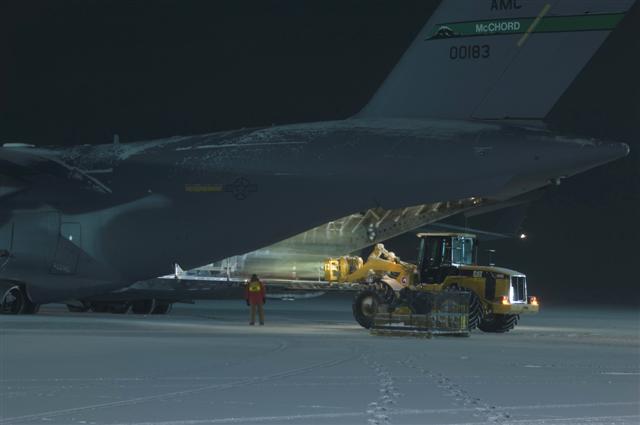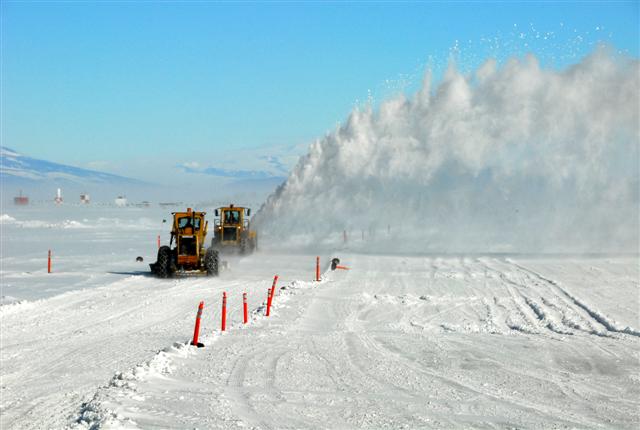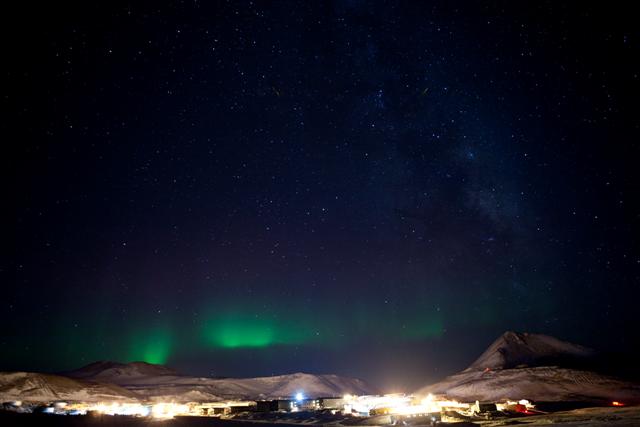Ramping upFlights for 2010 winfly season scheduled to arrive week early using night-vision gogglesPosted July 30, 2010
The first sunrise at McMurdo Station Seven flights are planned during the winter fly-in (Winfly) period, beginning on Aug. 13. Winfly is the time between winter and the summer when additional support personnel, such as carpenters and cooks, arrive to prepare the station for the upcoming science field season. U.S. Air Force crews from the 62nd and 446th Airlift Wings at Joint Base Lewis-McChord The U.S. Air Force has proven the concept of operating in the winter dark for the last two years. On Sept. 11, 2008, a McChord C-17 landed at Pegasus White Ice Runway using NVGs for the first time in Antarctic history. [See related article: Night vision.] The Air Force stands ready to make the concept a regular capability whenever the National Science Foundation (NSF) “We’re ready to take this next step. It’s a tremendous logistics capability,” Wellington said. 
Photo Credit: Bill Henriksen/Antarctic Photo Library
A dozer unloads a C-17 during the 2008 winfly season when the first night-vision goggle mission took place.

Photo Credit: Robyn Waserman/Antarctic Photo Library
Heavy machines prepare the annual sea ice runway near McMurdo Station.
He said the Air Force has used NVG technology for many years, and it is a standard part of advanced flight school training. “[NVGs] allow us to operate into fields we wouldn’t otherwise be able to operate into or out of, and they enhance safety,” he said. “Although NVGs don’t turn night into day, it sure helps.” The Aug. 13 scheduled flight is about a week earlier than the Air Force normally arrives in Antarctica for Operation Deep Freeze, a military term held over from the 1950s when the U.S. Navy handled most of the logistics for research on the continent, beginning with the International Geophysical Year Today, the support force is mostly civilian, with the military mainly providing air service between Christchurch, New Zealand, and McMurdo. The New York Air National Guard (NYANG) Wellington said the Air Force’s big concerns flying that early are extreme cold and rapidly changing weather. Historically, August is the coldest month in McMurdo, with a mean temperature of minus 25 degrees Fahrenheit. The planes will carry enough fuel so they won’t have to fill up at the airfield, meaning the engines will remain running while the military transport is on the ground for about an hour. The flight between New Zealand and Antarctica is about five hours each way. “The funny thing about our aircraft — and jets in general — is that once the plane is going, everything works great. It’s when you shut them down and try to start them back up again in the extreme cold that we increase the likelihood of a maintenance problem,” Wellington explained. Science is the driving force behind the early start to the Winfly season, according to Jessie Crain, research support manager in the NSF's Office of Polar Programs An international project between U.S. and French researchers called Concordiasi In addition, a team of biologists studying Weddell seal behavior are particularly interested in looking at the animal’s predation strategies under dark conditions. The extra week will buy the scientists more time for their work. By the end of the month, the sun is up for more than six-and-a-half hours. Daylight then gains about 15 minutes a day in September. By Oct. 24, the sun sits in the sky 24 hours a day. “It’s a real race against the clock for us,” said Randall Davis More than 400 people are expected to arrive in McMurdo in August, effectively tripling the station population and representing a larger-than-normal Winfly contingent. All of those extra hands will be needed this year: The main summer field season, kicking off in late September, also promises to be busier than usual. Several large deep-field camps are planned, including one in the central Transantarctic Mountains (CTAM) with more than 70 people. The CTAM researchers include dinosaur fossil hunters, along with additional paleontologists, geologists, glaciologists and others. Farther afield from McMurdo, the West Antarctic Ice Sheet (WAIS) Divide project A second large field camp, Byrd Surface Camp, will also operate in the region. Its primary mission is to support a traverse, or overland tractor train, to establish a base of operations for a major project beginning in 2011-12 that will study the rapidly thinning Pine Island Ice Shelf. [See related article: Byrd Camp resurfaces.] The U.S. Air Force is scheduled to fly more than 60 flights during the summer between Christchurch and McMurdo. The NYANG is slated to fly about 400 missions across the continent, with more than half of those moving passengers, cargo and fuel to the South Pole. The South Pole Station Pole is also expecting a busy field season. The IceCube Neutrino Observatory At Palmer Station Several new groups will deploy to Palmer, including a team that will operate an autonomous underwater vehicle (AUV) to study Adélie penguin foraging areas.
|



For USAP Participants |
For The Public |
For Researchers and EducatorsContact UsU.S. National Science FoundationOffice of Polar Programs Geosciences Directorate 2415 Eisenhower Avenue, Suite W7100 Alexandria, VA 22314 Sign up for the NSF Office of Polar Programs newsletter and events. Feedback Form |


